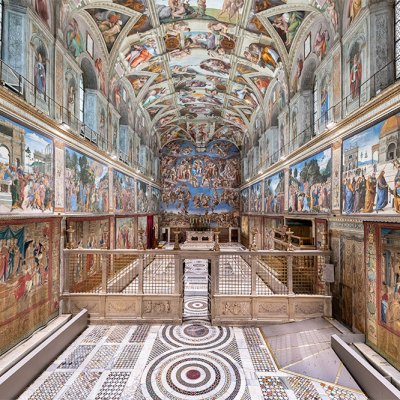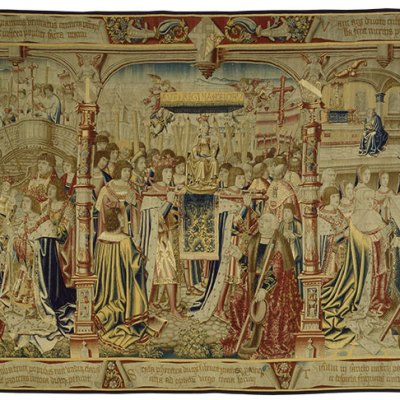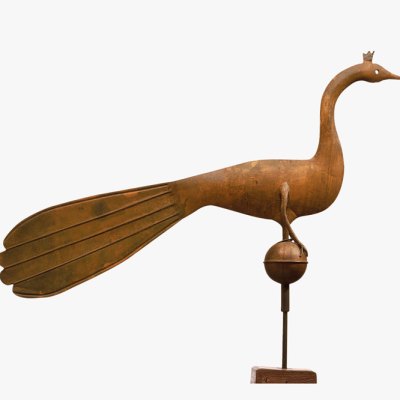From the June 2021 issue of Apollo. Preview and subscribe here.
The last Polish king of the Jagiellonian dynasty, Sigismund II Augustus (1520–72), son of Sigismund I the Old and his Milanese queen, Bona Sforza, was born in Wawel Royal Castle in Kraków. It was there that he grew up, and he would use the building as his main official residence for most of his life. When he died, he was buried in the cathedral on Wawel Hill. He was responsible, too, for the most important artistic commission connected to the castle. Over a decade, between 1550 and 1560, he ordered from Brussels 160 magnificent tapestries to decorate the royal apartments of the castle. The first set of these – showing biblical scenes – was probably intended for the coronation of Sigismund’s second and much-loved wife, Barbara Radziwiłł, in December 1550. It was, however, not displayed until a few years later, on 30 July 1553, during the king’s third wedding to Catherine of Austria, which followed Barbara’s untimely death in 1551. The king continued to order tapestries for Wawel in subsequent years.
Of the original 160 tapestries, 137 survive. Nineteen are biblical scenes, designed by Michiel Coxcie the Elder (1499–1592) and comprising episodes from the Old Testament, from Adam and Eve to the building of the Tower of Babel. Sigismund’s was the editio princeps of this series, much copied through to 1700. Of the remaining tapestries, 44 are verdures with animals – leopards, monkeys, camels, otters, boars, stags and fantastic reptiles, dragons and even a unicorn-giraffe (see p. 87). The king also ordered 26 tapestries with grotesque decorations around his intertwined initials, or around the arms of Poland and Lithuania. Another 37 tapestries were made to be placed around windows and over doors, with a combination of verdures and armorial designs. Finally 11 tapestries were used as seat covers (six with the ‘SA’ monogram and five with bouquets of flowers). All these tapestries belong to Wawel Castle, with the exception of two: the Moral Downfall of Mankind, which is owned by the Royal Castle in Warsaw, and an arcade for an over-window, now at the Rijksmuseum in Amsterdam.
Heavenly Bliss, from the series History of the First Parents (1550–60), designed by Michiel Coxcie the Elder, woven by workshop of Jan de Kempeneer. Wawel Royal Castle, Kraków. Photo: Tomasz Śliwiński
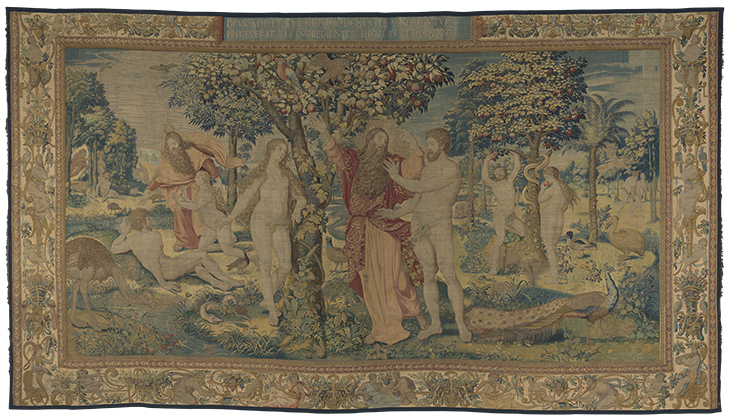
All the tapestries, bar the arcade from Amsterdam, are now on view together at Wawel for a few months and can be admired in 21 rooms over the two principal floors of the castle. The tapestries are shown on the walls and sometimes (depending on their state of conservation) in vitrines. Two of the largest rooms at Wawel – the Envoys’ Hall and the Senators’ Hall – have been entirely lined with the Flemish tapestries, giving a very clear sense of the luxury and the glorious effect of these works of art in a royal residence. Many of the over-doors, over-windows, under-windows and arcades have been placed in their original locations, showing how the hangings were originally meant to cover every surface of the castle. The verdures with their animals populate the gaps between the biblical scenes, and are in a number of other rooms and on the Envoys’ Staircase. Text panels and vitrines with comparative objects tell the story of the making of the tapestries and of their more recent conservation.
After Sigismund’s death, the tapestries became the property of the Polish crown and were often used for coronations, royal weddings and important ceremonies, both at the castle and in the cathedral. Even in modern times, the Jagiellonian tapestries have been present at some of the key events of Polish history. In May 1935, for example, the tapestry of God Blessing Noah’s Family was hung over the Vasa Gate of Wawel during the state funeral of Józef Piłsudski, the pater patriae of the Republic of Poland. In August 2002, some of the tapestries were displayed along the gallery of the courtyard of the castle for the visit of Pope John Paul II.
Tapestry with the coats of arms of Poland and Lithuania and a figure of Ceres (1550–60), designed by an artist from the circle of Cornelis Floris and Cornelis Bos, woven by the workshop of Frans Ghieteels. Wawel Royal Castle, Kraków. Photo: Tomasz Śliwiński
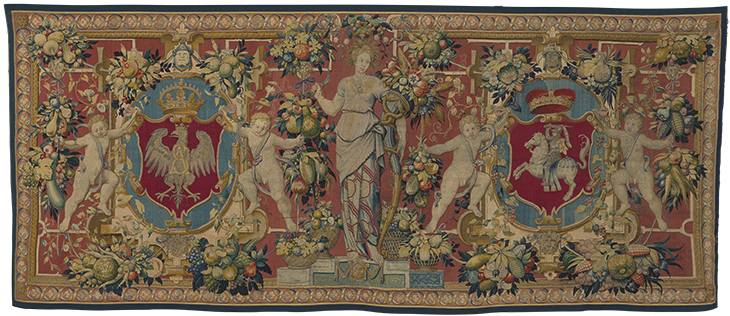
Yet the history of the tapestries has – unsurprisingly, given the history of Poland – not been as straightforward and glorious as it may first appear. In 1669 John II Casimir Vasa, short of cash after his abdication, pawned the tapestries in Gdańsk. After the third and final partition of Poland (1795), and the country’s effective disappearance from the map of Europe for more than a century, the tapestries were brought to Russia and displayed in a number of locations in St Petersburg, and at Gatchina Palace. The Treaty of Riga, signed in March 1921, asserted that the ‘collections of works of art’ (among other objects) should be restored to Poland ‘irrespective of the conditions under which, and the pretexts upon which they were carried off and irrespective of the authorities responsible for such removal.’ Between 1921 and 1928, all the tapestries in Russia were returned to Poland.
An Otter with a Fish in its Mouth (1550–60), designed by an artist from the school of Pieter Coecke van Aelst,
woven by the workshop of Jan van Tieghem. Wawel Royal Castle, Kraków Photo: Tomasz Śliwiński
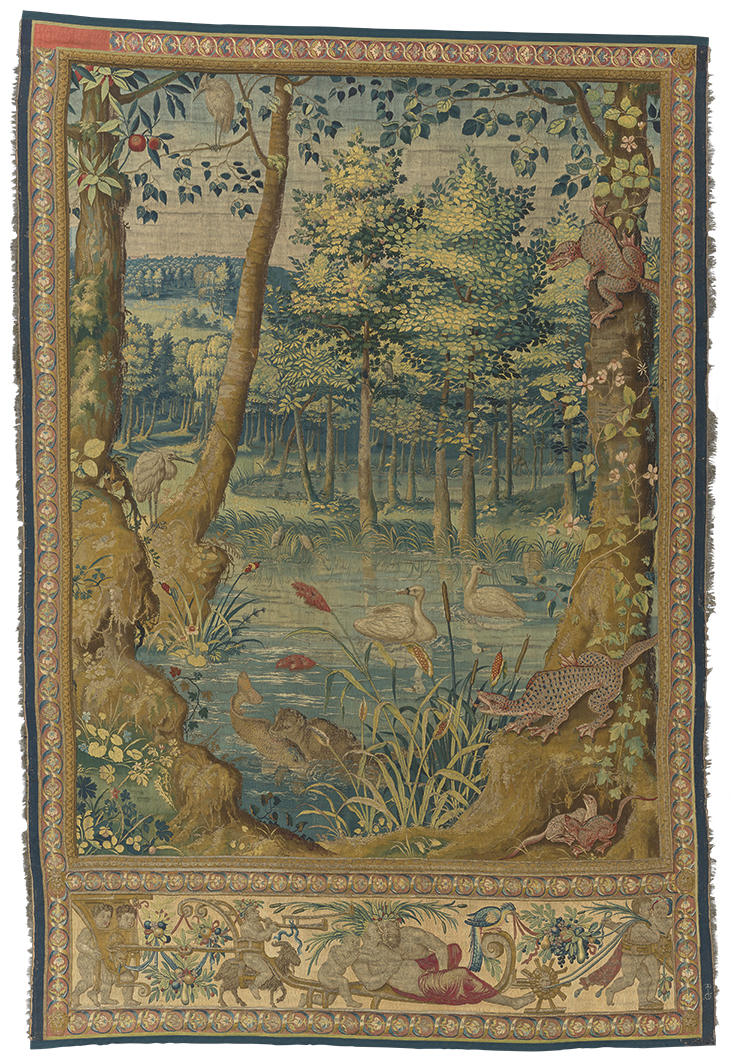
Only ten years after their restitution to Poland, however, the tapestries faced a much worst threat. Just two days after the Nazi invasion of Poland, on 3 September 1939, the national treasures of Poland, starting with the Wawel tapestries, were evacuated. The chief curator at Wawel, Stanisław Świerz-Zaleski, and the architect Józef Krzywda-Polkowski organised the transportation of the works. A map in the exhibition charts their travels during the war. Via the river Vistula, the tapestries reached Kazimierz and then, by truck and carts, were moved to Romania. They were subsequently shipped through Malta and Genoa to Marseille, and across France to the United Kingdom, from where they were transported to Canada and stored at the National Archives in Ottawa. They remained there for the duration of the war, under the watchful eyes of Świerz-Zaleski and Krzywda-Polkowski. But after the war, a controversy arose about returning the treasures to a Communist country, and the tapestries were transferred to Québec, only to be finally sent back to Poland in 1961. The present exhibition, then, commemorates the centenary of the Treaty of Riga and the 60th anniversary of the second restitution of these tapestries, from Canada – and it is a delight to see them in their rightful place.
‘All the King’s Tapestries: Homecomings 2021–1961–1921’ is at Wawel Royal Castle, Kraków, until 31 October.
From the June 2021 issue of Apollo. Preview and subscribe here.

